
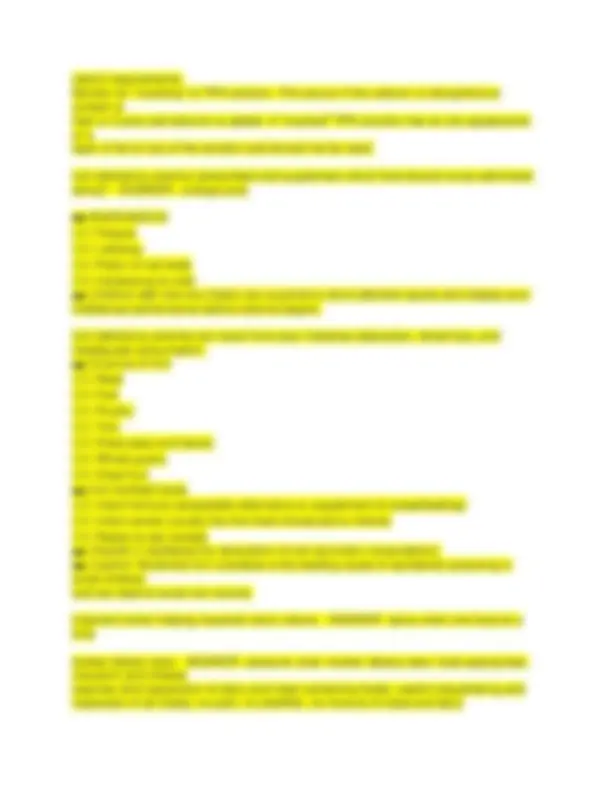

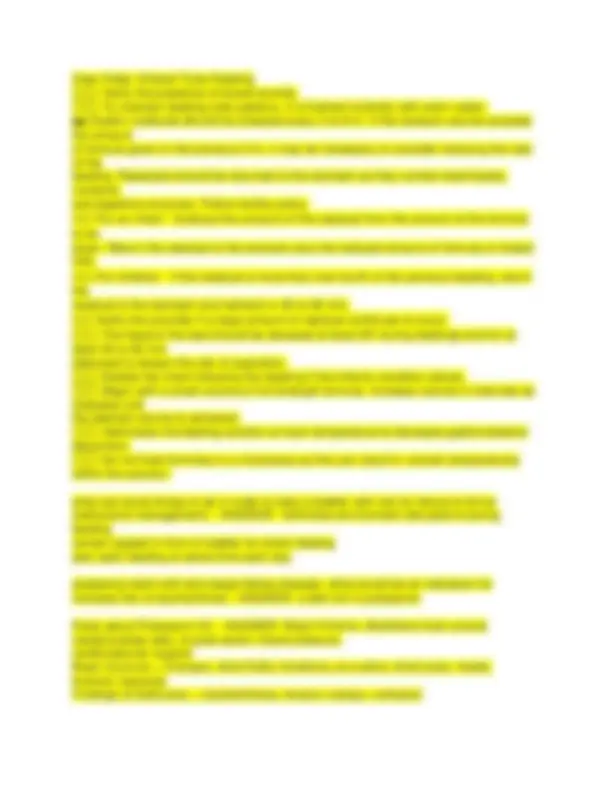
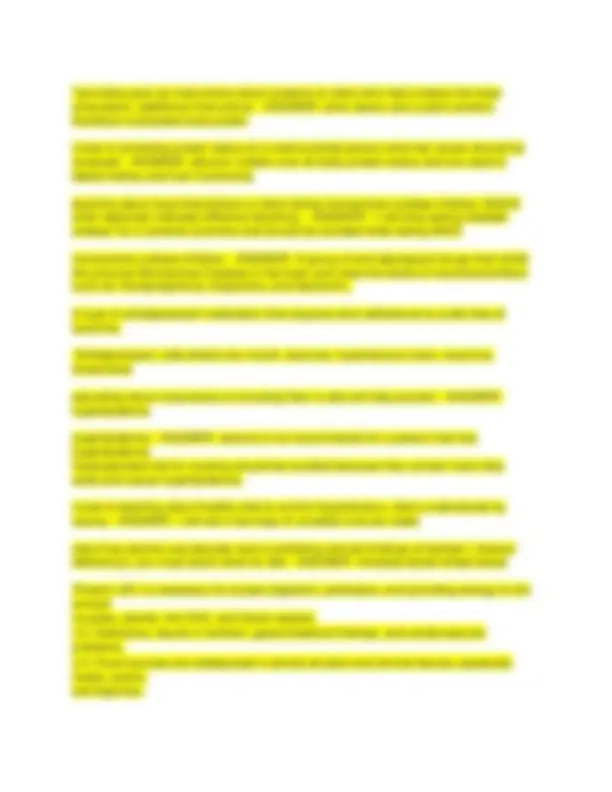
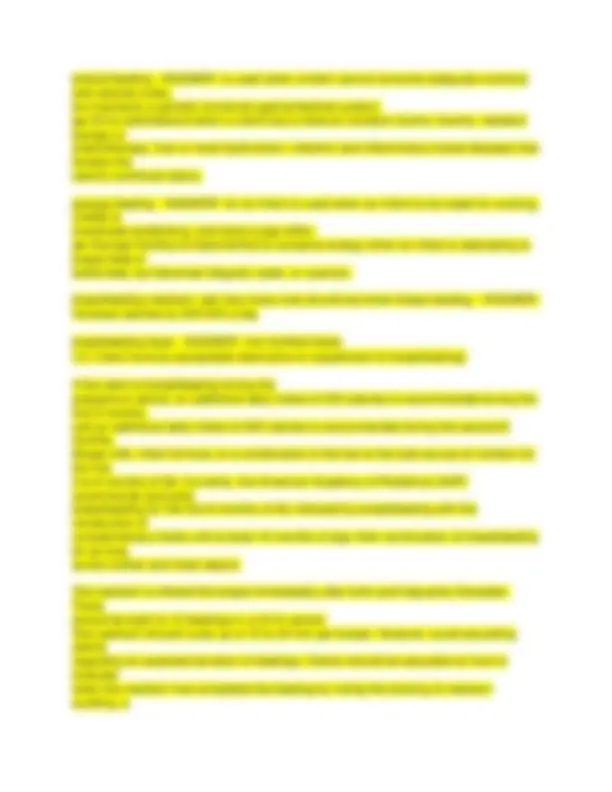
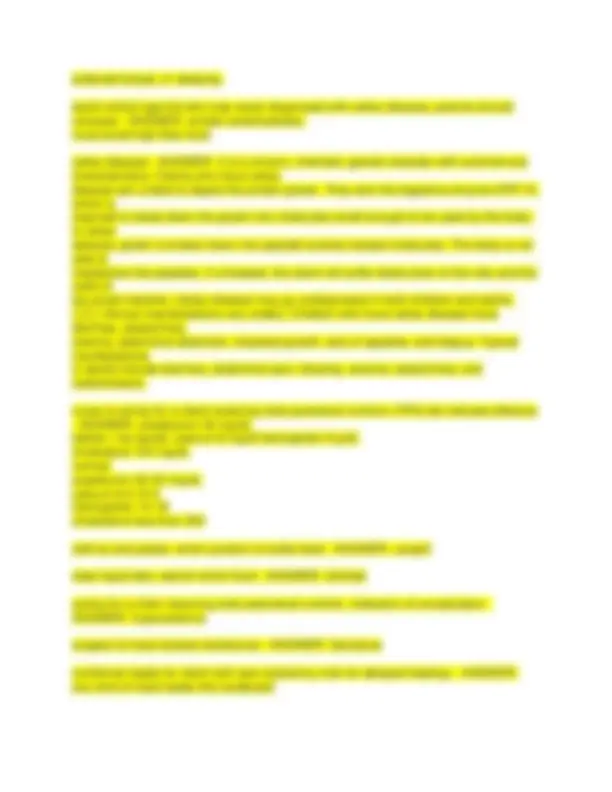
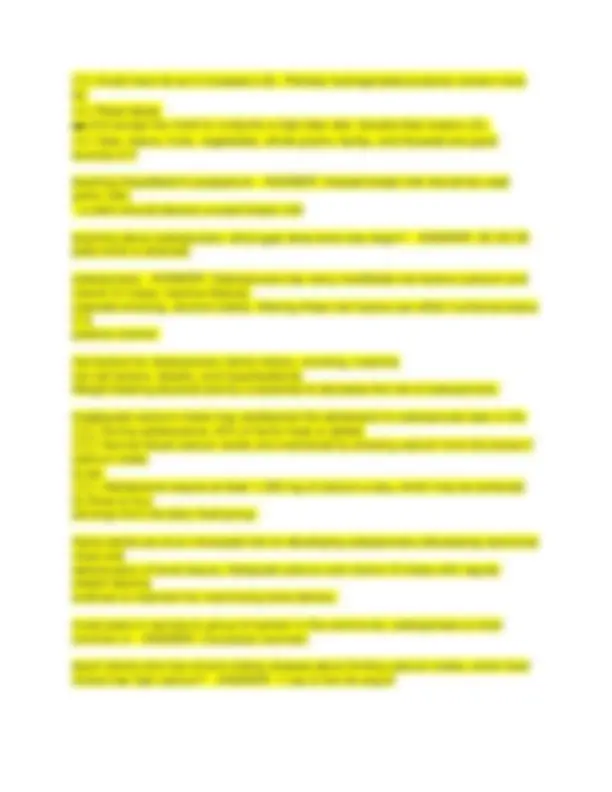
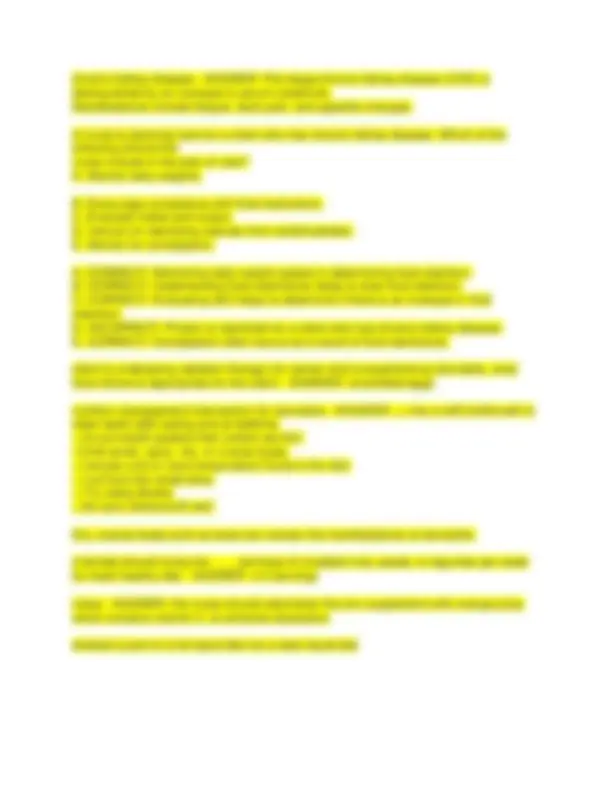



Study with the several resources on Docsity

Earn points by helping other students or get them with a premium plan


Prepare for your exams
Study with the several resources on Docsity

Earn points to download
Earn points by helping other students or get them with a premium plan
Community
Ask the community for help and clear up your study doubts
Discover the best universities in your country according to Docsity users
Free resources
Download our free guides on studying techniques, anxiety management strategies, and thesis advice from Docsity tutors
ATI NUTRITION A QUESTIONS WITH CORRECT DETAILED ANSWERS 2025.pdf
Typology: Exams
1 / 15

This page cannot be seen from the preview
Don't miss anything!










you are admitting a patient with anorexia what measures will you take regarding food - ANSWER- assign privileges based on weight gain what food item is appropriate to consume for a patient who has celiac disease - ANSWER- potatoes (gluten free) (food items that are not gluten free: bread, pudding, brand muffin, graham cracker), For this disease, eliminate gluten from diet, give vitamin (ADEK - fat soluble) supplements. Can have rice & corn. It is a chronic, inherited, genetic disorder with autoimmune characteristics. Clients who have celiac disease are unable to digest the protein gluten. They lack the digestive enzyme DPP-IV, which is required to break down the gluten into molecules small enough to be used by the body. In celiac disease, gluten is broken down into peptide strands instead molecules. The body is not able to metabolize the peptides. If untreated, the client will suffer destruction of the villa and the walls of the small intestine. Celiac disease may go undiagnosed in both children and adults. a patient with diabetes 1 mellitus assess somogyi phenomenon - ANSWER- monitor blood glucose levels during the night when performing enteral tube feeding you must - ANSWER- increase volume of formula over first 4-6 feedings , a method of feeding by providing a liquid diet directly to the stomach or intestine through a tube placed down the throat or through the wall of the GI tract what is a normal lab value for a person with type 2 diabetes - ANSWER- HbA1c of 6.5% abnormal: serum creatine 1.5 mg/dL BUN of 25 mg/dL pre-meal blood glucose of 145 mg/dL If you had a fasting blood glucose test: •A level of 100-125mg/dL means you have impaired fasting glucose, a type of prediabetes. This increases your risk for type 2 diabetes. •A level of 126 mg/dL and higher most often means you have diabetes gastric bypass surgery - ANSWER- start each meal with protein ,
: surgically makes the stomach smaller and causes food to bypass the first part of the small intestine. this procedure is not reversible somogyi phenomenon - ANSWER- is fasting hyperglycemia that occurs in morning in response to hypoglycemia during the night time. the nurse assesses for this phenomenon by monitoring blood glucose levels during the night. Usually occurs during the night, but manifests as an elevated glucose in the morning and may be inadvertently treated with an increase in insulin dosage. Check blood glucose around 3:00 a.m. Adjusting insulin to avoid peaking during the night will correct this effect. enteral feeding must report: - ANSWER- report sodium 128 mEq/L. this finding is the priority to report to provider. normal range for blood sodium levels is 135 to 145 milliequivalents per liter ... hyponatremia occurs when hyperosmolar enteral feedings are being administered too rapidly and places client at risk for dehydration. it is important that formula be prepared as directed. diluting formula can decrease its nutritional content and cause inadequate weight gain. Nutrients supplied to the gastrointestinal tract orally or by feeding tube. engaging in what activity will burn more calories - ANSWER- 125 lb person; playing soccer ` diverticulitis - ANSWER- limit fiber intake when experiencing manifestations. Infected or inflamed pouch (diverticulum) in the colon. Common in older persons; Low- fiber diet and constipation are risk factors. type I diabetes (how to count carbs) - ANSWER- "I know the serving size can affect the number of carbs I can eat :A chronic metabolic disease characterized by high blood sugar (glucose) levels associated with the inability of the pancreas to produce insulin; also called insulin- dependent diabetes mellitus (IDDM) or juvenile-onset diabetes. total parenteral nutrition ( no bag available what should nurse do?) - ANSWER- :administer dextrose 10% in water TPN provides a nutritionally complete solution. It can be used when caloric needs are very high, when the anticipated duration of therapy is greater than 7 days, or when the solution to be administered is hypertonic (composed of greater than 10% dextrose). It can only be administered in a central vein. TPN is commonly used in clients undergoing treatment for cancer, bowel disorders, and those suffering from trauma or extensive burns, as these conditions are associated with high
helping a client with nutrition who has hypernatremia - ANSWER- items low in sodium: orange wedge, tomatoe-Brown rice tip to give a pregnant women to help with nausea - ANSWER- "I will eat dry cereal before I get out of bed"For nausea, eat dry crackers or toast. Avoid alcohol, caffeine, fats, and spices. Avoid drinking fluids with meals, and do not take medications to control nausea without checking with the provider. client chemotherapy adequate nutrition - ANSWER- " I have maintained my weight since start treatmetns expected acute pancreatitis labs - ANSWER- increase serum glucose due to decrease insulin production by pancreas Nutritional therapy for acute pancreatitis involves reducing pancreatic stimulation. The client is prescribed nothing by mouth (NPO), and a nasogastric tube is inserted to suction gastric contents. what should the nurse recommend to a client who has a Ca prescription in order to increase calcium absorption - ANSWER- take supplements that contain vitamin D to improve calcium absorption list things that a nurse must do in order to prevent dysphagia when giving oral feeding - ANSWER- * gently palpate clients throat during swallowing
View Video: Enteral Tube Feeding ◯◯ Verify the presence of bowel sounds. ◯◯ To maintain feeding tube patency, it is flushed routinely with warm water. ■■ Gastric residuals should be checked every 4 to 6 hr. If the residual volume exceeds the amount of formula given in the previous 2 hr, it may be necessary to consider reducing the rate of the feeding. Residuals should be returned to the stomach as they contain electrolytes, nutrients, and digestive enzymes. Follow facility policy. ☐☐ For an infant - Subtract the amount of the residual from the amount of the formula to be given. Return the residual to the stomach plus the reduced amount of formula or breast milk. ☐☐ For children - If the residual is more than one fourth of the previous feeding, return the residual to the stomach and recheck in 30 to 60 min. ☐☐ Notify the provider if a large amount of residual continues to occur. ◯◯ The head of the bed should be elevated at least 30º during feedings and for at least 30 to 60 min afterward to lessen the risk of aspiration. ◯◯ Bubble the infant following the feeding if the infant's condition allows. ◯◯ Begin with a small volume of full-strength formula. Increase volume in intervals as tolerated until the desired volume is achieved. ◯◯ Administer the feeding solution at room temperature to decrease gastrointestinal discomfort. ◯◯ Do not heat formulas in a microwave as this can result in uneven temperatures within the solution. what are some things to do in order to help a toddler with risk for failure to thrive (behavioral management) - ANSWER- *eliminate environment disruptions during feeding remain seated in front of toddler for entire feeding plan each feeding at same time each day assessing client with end-stage kidney disease, what would be an indication for increase risk of dysrhythmias - ANSWER- a diet rich in potassium Facts about Potassium (K) - ANSWER- Major Actions ››Maintains fluid volume inside/outside cells, muscle action, blood pressure, cardiovascular support Major Sources ›› Oranges, dried fruits, tomatoes, avocados, dried peas, meats, broccoli, bananas Findings of Deficiency ›› Dysrhythmias, muscle cramps, confusion
☐☐ Phosphate binders (e.g., calcium carbonate, calcium acetate) must be taken with all meals and snacks. ■■ Vitam nurse is caring for a client with age related macular degeneration are there any recommendations for nutritional changes to consider? - ANSWER- increase dietary intake of lutein age related macular degeneration - ANSWER- Age-related macular degeneration (AMD) is a deterioration or breakdown of the eye's macula. The macula is a small area in the retina — the light-sensitive tissue lining the back of the eye. The macula is the part of the retina that is responsible for your central vision, allowing you to see fine details clearly Lutein and zeaxanthin are macular pigments that may play a role in reducing the development and progression of age-related macular degeneration. Evidence is accumulating on the consumption of lutein and zeaxanthin (in whole food or supplemental form), the resulting concentrations in the serum, and tissue distribution throughout the body, particularly in the retina. Lutein and zeaxanthin intake increases serum concentrations which in turn increases macular pigment density the nurse is teaching a client about low-residue diet. which food choice indicates understanding of teaching - ANSWER- two-egg cheese omelet and banana a low residue diet limits the amount of stool traveling through intestine tract A low-residue diet is a diet in which fiber and other foods that are harder for your body to digest are restricted. Fiber is made up of plant material that cannot be completely digested by the body. High-fiber foods include whole-grain breads and cereals, nuts, seeds, and raw or dried fruits. Residue refers to undigested foods, including fiber, that make up stool. If intestinal walls are inflamed or damaged, digestion and absorption of nutrients and water may be impaired, depending on the location of disease activity what response from mom who wants to bottle feed formula indicates a need for further teaching - ANSWER- "I will add more water to formula if baby has diarrhea" during a class for woman of child bearing age, what food source should be recommended to take in order to have adequate folate - ANSWER- 3.5 oz chicken liver what should you do if a client does not like the taste of a nutritional supplement? - ANSWER- offer a nutritionally comparable supplement offer it chilled to improve taste what would be the first action to take on an obese client who wants to lose weight - ANSWER- obtain 24 hr dietary recall
?providing post op instructions about proteins to client who had a below the knee amputation, additional instructions - ANSWER- pinto beans (are a plant protein) therefore incomplete food protein nurse is reviewing protein status of a malnourished person what lab values should be reviewed - ANSWER- albumin (reflect over all body protein status and are used to detect kidney and liver functioning teaching about food interactions to client taking monoamine oxidase inhibitor (MAOI) what response indicates effective teaching: - ANSWER- "I will stop eating cheddar cheese" bc it contains tyramine and should be avoided while taking MAOI monoamine oxidase inhibitor - ANSWER- A group of anti-depressant drugs that inhibit the enzyme Monoamine Oxidase in the brain and raise the levels of neurotransmitters such as--Norepinephrine, Dopamine, and Serotonin., A type of antidepressant medication that requires strict adherence to a diet free of tyramine, Antidepressant, side effects dry mouth, seizures, hypertensive crisis, insomnia, drowsiness educating about importance of including fiber in diet will help prevent - ANSWER- hyperlipidemia hyperlipidemia - ANSWER- alcohol is not recommened for a person that has hyperlipidemia Hydrogenated oils for cooking should be avoided because they contain trans fatty acids and cause hyperlipidemia. nurse is teaching about healthy diet to control hypertension, client understands by saying - ANSWER- I will eat 4 servings of unsalted nuts per week client has alcohol use disorder and is exhibiting clinical finidings of beriberi ( thiamin deficiency), you must teach what for diet - ANSWER- increase whole wheat bread Thiamin (B1) is necessary for proper digestion, peristalsis, and providing energy to the smooth muscles, glands, the CNS, and blood vessels. ☐☐ Deficiency results in beriberi, gastrointestinal findings, and cardiovascular problems. ☐☐ Food sources are widespread in almost all plant and animal tissues, especially meats, grains, and legumes.
softened breast, or sleeping. teach school age kid who was newly diagnosed with celiac disease, parents should increase - ANSWER- simple carbohydrates, must avoid high fiber food celiac disease - ANSWER- It is a chronic, inherited, genetic disorder with autoimmune characteristics. Clients who have celiac disease are unable to digest the protein gluten. They lack the digestive enzyme DPP-IV, which is required to break down the gluten into molecules small enough to be used by the body. In celiac disease, gluten is broken down into peptide strands instead molecules. The body is not able to metabolize the peptides. If untreated, the client will suffer destruction of the villa and the walls of the small intestine. Celiac disease may go undiagnosed in both children and adults. ◯◯ Clinical manifestations vary widely. Children who have celiac disease have diarrhea, steatorrhea, anemia, abdominal distention, impaired growth, lack of appetite, and fatigue. Typical manifestations in adults include diarrhea, abdominal pain, bloating, anemia, steatorrhea, and osteomalacia. nurse is caring for a client receiving total parenteral nutrition (TPN) lab indicate effective
lactose intolerance - ANSWER- Client Education ●● Lactose intolerance is due to an inadequate level of lactase. The enzyme that converts lactose into glucose and galactose is absent or insufficient. ●● Clinical Manifestations ◯◯ Abdominal distension ◯◯ Cramps ◯◯ Flatus ◯◯ Diarrhea ●● Foods to limit or avoid: milk, cheese, ice cream, cream soups, puddings, chocolate. Nuts and beans are significant sources of protein. These are good alternatives for a dairy allergy or lactose intolerance. Either soy-based (ProSobee or Isomil) or casein hydrolysate (Nutramigen or Pregestimil) formulas can be prescribed as alternative formulas for infants who are lactose intolerant. colostomy - ANSWER- An ostomy is a surgically created opening on the surface of the abdomen from either the end of the small intestine (ileostomy) or from the colon (colostomy). ◯◯ Fluid and electrolyte maintenance is the primary concern for clients who have ileostomies and colostomies. ◯◯ The colon absorbs large amounts of fluid, sodium, and potassium. ◯◯ Nutrition therapy begins with liquids only and is slowly advanced based upon client tolerance. ◯◯ Nursing Interventions ■■ Advise the client to consume a diet that is high in fluids and soluble fiber. ■■ Encourage the client to avoid foods that cause gas (beans, eggs, carbonated beverages), stomal blockage (nuts, raw carrots, popcorn), and foods that produce odor (eggs, fish, garlic). ■■ Encourage the client to increase his intake of calories and protein to promote healing of the stoma site. ■■ Provide emotional support to clients due to their altered body image. nurse is discussing prenatal education, mom plans to breast feed best time is - ANSWER- breastfeeding immediately following birth. within 1hr. of delivery to promote successful breastfeeding teaching about healthy eating; your total fat intake should be - ANSWER- between 20- 35% of calories per day cholesterol should be 200-300 a day
☐☐ Avoid trans fat as it increases LDL. Partially hydrogenated products contain trans fat. ☐☐ Read labels. ■■ Encourage the client to consume a high-fiber diet. Soluble fiber lowers LDL. ☐☐ Oats, beans, fruits, vegetables, whole grains, barley, and flaxseed are good sources of fi teaching breastfeed in postpartum - ANSWER- thawed breast milk should be used within 24hr
chronic kidney disease - ANSWER- Pre-stage chronic kidney disease (CKD) is distinguished by an increase in serum creatinine. Manifestations include fatigue, back pain, and appetite changes. A nurse is planning care for a client who has chronic kidney disease. Which of the following should the nurse include in the plan of care? A. Monitor daily weights. B. Encourage compliance with fluid restrictions. C. Evaluate intake and output. D. Instruct on restricting calories from carbohydrates. E. Monitor for constipation. A. CORRECT: Monitoring daily weight assists in determining fluid retention. B. CORRECT: Implementing fluid restrictions helps to slow fluid retention. C. CORRECT: Evaluating I&O helps to determine if there is an increase in fluid retention. D. INCORRECT: Protein is restricted for a client who has chronic kidney disease. E. CORRECT: Constipation often occurs as a result of fluid restrictions. client is undergoing radiation therapy for cancer and is experiencing stomatitis. what food choice is appropriate for the client - ANSWER- scrambled eggs nutrition management intervention for stomatitis - ANSWER- ›› Use a soft toothbrush to clean teeth after eating and at bedtime. ›› Avoid mouth washes that contain alcohol. ››Omit acidic, spicy, dry, or coarse foods. ›› Include cold or room temperature foods in the diet. ›› Cut food into small bites. ›› Try using straws. ›› Be sure dentures fit well. Dry, coarse foods such as toast can worsen the manifestations of stomatitis. a female should consume ____servings of unsalted nuts, seeds, or legumes per week for heart healthy diet - ANSWER- 4 - 5 servings notes - ANSWER- the nurse should administer the iron supplement with orange juice, which contains vitamin C, to enhance absorption sherbet is part of a full liquid diet not a clear liquid diet